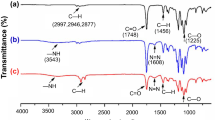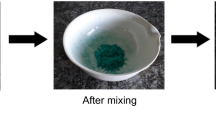Abstract
A specific copper complex is used here for the development of new antibacterial coatings against two different bacteria strains i.e. Escherichia coli (E. coli) and Staphylococcus aureus (S. aureus). Remarkably, the cationic polymerization of a glycerol-derived monomer was performed using an efficient Cu complex as a photoinitiator. The synthesized coatings which were successfully developed under UV–visible light exposure and under a solvent-free cationic photopolymerization process show excellent adhesion on stainless steel plate according to nanoindentation and scratch tests. The resulting glycerol-derived coatings have been conducted to assess the antibacterial activities against E. coli and S. aureus: a tremendous decrease of 99.9% and 96% of the adhered Escherichia coli and Staphylococcus aureus on the surface of copper containing coatings has been demonstrated in comparison with bare stainless steel supports. Finally, our investigation suggests from live/dead assays data that the synthesized polymer films show biocidal properties due to the release of Cu2+ ions, which are responsible for inhibiting bacterial proliferation.








Similar content being viewed by others
References
Peleg AY, Hooper DC (2010) Hospital-acquired infections due to gram-negative bacteria. N Engl J Med 362:1804–1813
Curtis LT (2008) Prevention of hospital-acquired infections: review of non-pharmacological interventions. J Hosp Infect 69:204–219
Khan HA, Baig FK, Mehboob R (2017) Nosocomial infections: epidemiology, prevention, control and surveillance. Asian Pac J Trop Biomed 7:478–482
Park KD, Kim YS, Han DK, Kim YH, Lee EHB, Suh H, Choi KS (1998) Bacterial adhesion on PEG modified polyurethane surfaces. Biomaterials 19:851–859
Ostuni E, Chapman RG, Liang MN, Meluleni G, Pier G, Ingber DE, Whitesides GM (2001) Self-assembled monolayers that resist the adsorption of proteins and the adhesion of bacterial and mammalian cells. Langmuir 17:6336–6343
Genzer J, Menko KE (2006) Recent developments in superhydrophobic surfaces and their relevance to marine fouling: a review. Biofouling 22:339–360
Manecka GM, Labrash J, Rouxel O, Dubot P, Lalevée J, Abbad Andaloussi S, Renard E, Langlois V, Versace DL (2014) Green photoinduced modification of natural poly(3-hydroxybutyrate-co-3-hydroxyvalerate) surface for antibacterial applications. ACS Substain Chem Eng 2:996–1006
El Habnouni S, Darcos V, Garric X, Lavigne J-P, Nottelet B, Coudane J (2011) Mild methodology for the versatile chemical modification of polylactide surfaces: original combination of anionic and click chemistry for biomedical applications. Adv Funct Mater 21:3321–3330
Feiertag P, Albert M, Ecker-Eckhofen E-M, Hayn G, Hönig H, Oberwalder HW, Saf R, Schmidt A, Schmidt O, Topchiev D (2003) Structural characterization of biocidal oligoguanidines. Macromol Rapid Commun 24:567–570
Schmitt MA, Weisblum B, Gellman SH (2004) Unexpected relationships between structure and function in alpha, beta-peptides: antimicrobial foldamers with heterogeneous backbones. J Am Chem Soc 126:6848–6849
Schmitt MA, Weisblum B, Gellman SH (2006) Interplay among folding, sequence, and lipophilicity in the antibacterial and hemolytic activities of α/β-peptides. J Am Chem Soc 129:417–428
Kenawy ER, Mahmoud YAG (2003) Biologically active polymers, 6 synthesis and antimicrobial activity of some linear copolymers with quaternary ammonium and phosphonium groups. Macromol Biosci 3:107–116
Chang Y, Yandi W, Chen WY, Shih YJ, Yang CC, Ling QD, Higuchi A (2010) 1101, Tunable bioadhesive copolymer hydrogels of thermoresponsive poly(N-isopropyl acrylamide) containing zwitterionic polysulfobetaine. Biomacromol 11(2010):1101–1110
Perni S, Piccirillo C, Pratten J, Prokopovich P, Chrzanowski W, Parkin IP, Wilson M (2009) The antimicrobial properties of light-activated polymers containing methylene blue and gold nanoparticles. Biomaterials 30:89–93
Decraene V, Pratten J, Wilson M (2006) Cellulose acetate containing toluidine blue and rose bengal is an effective antimicrobial coating when exposed to white light. Appl Environ Microbiol 72:4436–4439
Condat M, Mazeran P-E, Malval J-P, Lalevée J, Morlet-Savary F, Renard E, Langlois V, Abbad Andaloussi S, Versace D-L (2015) Photoinduced curcumin derivative-coatings with antibacterial properties. RSC Adv 5:85214–85224
Condat M, Babinot J, Tomane S, Malval J-P, Kang I-K, Spillebout F, Mazeran P-E, Lalevée J, Andaloussi SA, Versace D-L (2016) Development of photoactivable glycerol-based coatings containing quercetin for antibacterial applications. RSC Adv 6:18235–18245
Sautrot-Ba P, Contreras A, Abbad Andaloussi S, Coradin T, Helary C, Razza N, Sangermano M, Mazeran P-E, Malval J-P, Versace D-L (2017) Eosin-mediated synthesis of polymer coatings combining photodynamic inactivation and antimicrobial properties. J Mater Chem B 5:7572–7582
Versace D-L, Ramier J, Grande D, Abbad Andaloussi S, Dubot P, Hobeika N, Malval J-P, Lalevee J, Renard E, Langlois V (2013) Versatile photochemical surface modification of biopolyester microfibrous scaffolds with photogenerated silver nanoparticles for antibacterial activity. Adv Healthcare Mater 2:1008–1018
Lorenzini C, Haider A, Kang I-K, Sangermano M, Abbad-Andalloussi S, Mazeran P-E, Lalevée J, Renard E, Langlois V, Versace D-L (2015) Photoinduced development of antibacterial materials derived from isosorbide moiety. Biomacromolecules 16:683–694
Tang Z, Kotov NA, Magonov S, Ozturk B (2003) Nanostructured artificial nacre. Nat Mater 2:413–418
Podsiadlo P, Paternel S, Rouillard JM, Zhang Z, Lee J, Lee JW, Gulari E, Kotov NA (2005) Layer-by-layer assembly of nacre-like nanostructured composites with antimicrobial properties. Langmuir 21:11915–11921
Amna T, Hassan MS, Barakat NAM, Pandeya DR, Hong ST, Khil M-S, Kim HY (2012) Antibacterial activity and interaction mechanism of electrospun zinc-doped titania nanofibers. Appl Microbiol Biotechnol 93:743–751
Chou P-T, Chi Y, Chung M-W, Lin C-C (2011) Harvesting luminescence via harnessing the photophysical properties of transition metal complexes. Coord Chem Rev 255:2653–2665
Reiser O (2016) Shining light on copper: unique opportunities for visible-light-catalyzed atom transfer radical addition reactions and related processes. Acc Chem Res 49:1990–1996
Zivic N, Bouzrati-Zerelli M, Kermagoret A, Dumur F, Fouassier J-P, Gigmes D, Lalevée J (2016) Photocatalysts in polymerization reactions. ChemCatChem 8:1617–1631
Pan X, Lamson M, Yan J, Matyjaszewski K (2015) Photoinduced metal-free atom transfer radical polymerization of acrylonitrile. ACS Macro Lett 4:192–196
Murtezi E, Yagci Y (2014) Simultaneous photoinduced ATRP and CuAAC reactions for the synthesis of block copolymers. Macromol Rapid Commun 35:1782–1787
Yagci Y, Tasdelen MA, Jockusch S (2014) Reduction of Cu(II) by photochemically generated phosphonyl radicals to generate Cu(I) as catalyst for atom transfer radical polymerization and azide-alkyne cycloaddition click reactions. Polymer 55:3468–3474
Dietlin C, Schweizer S, Xiao P, Zhang J, Morlet-Savary F, Graff B, Fouassier J-P, Lalevée J (2015) Photopolymerization upon LEDs: new photoinitiating systems and strategies. Polym Chem 6:3895–3912
Dumur F (2015) Recent advances in organic light-emitting devices comprising copper complexes: a realistic approach for low-cost and highly emissive devices? Org Electron 21:27–39
Paria S, Reiser O (2014) Copper in photocatalysis. ChemCatChem 6:2477–2483
Al Mousawi A, Kermagoret A, Versace D-L, Toufaily J, Hamieh T, Graff B, Dumur F, Gigmes D, Fouassier JP, Lalevée J (2017) Copper photoredox catalysts for polymerization upon near UV or visible light: structure/reactivity/efficiency relationships and use in LED projector 3D printing resins. Polym Chem 8:568–580
Block SS (2001) Definition in terms. In: Block SS (ed) Disinfection, sterilisation and preservation, 5th edn. Lippincott Williams and Wilkins, Philadelphia, pp 1857–1873
Dollwet HHA, Sorenson JRJ (2001) Historic uses of copper compounds in medicine. Trace elements in medicine, 2nd edn. The Humana Press Inc., Arkansas, pp 80–87
Gabbay J, Borkow G, Mishal L, Magen E, Zatcoff R, Shemer-Avni Y (2006) Copper oxide impregnated textiles with potent biocidal activities. J. Ind. Text. 35:323–335
Hubacher D, Lara-Ricalde R, Taylor DJ, Guerra-Infante F, Guzman-Rodriguez R (2001) Use of copper intrauterine devices and the risk of tubal infertility among Nulligravid women. N Engl J Med 345:561–567
Hostynek JJ, Maibach HI (2003) Copper hypersensitivity: dermatologic aspects–an overview. Rev Environ Health 18:153–183
McDonnell G, Russell AD (1999) Antiseptics and disinfectants: activity, action, and resistance. Clin Microbiol Rev 12:147–179
Gandini A (2008) Polymers from renewable resources: a challenge for the future of macromolecular materials. Macromolecules 41:9491–9504
Coates GW, Hillmyer MA (2009) A virtual issue of macromolecules: “polymers from renewable resources”. Macromolecules 42:7987–7989
Grass G, Rensing C, Solioz M (2011) Metallic copper as an antimicrobial surface. Appl Environ Microscop 77:1541–1547
Peter Pappas S, Pappas BC, Gatechair LR, Schnabel W (1984) Photoinitation of cationic polymerization. II. Laser flash photolysis of diphenyliodonium salts. J Polym Sci Polym Chem Ed 22:69–76
Peter Pappas S, Pappas BC, Gatechair LR, Jilek JH, Schnabel W (1984) Photoinitiation of cationic polymerization. IV. Direct and sensitized photolysis of aryl lodonium and sulfonium salts. Polym Photochem 5:1–22
Desimoni E, Casella GI, Monroe A, Salvi AM (1990) XPS determination of oxygen-containing functional groups on carbon-fibre surfaces and the cleaning of these surfaces. Surf Interface Anal 15:627–634
Desimoni E, Casella GI, Salvi AM (1992) XPS/XAES study of carbon fibres during thermal annealing under UHV conditions. Carbon 30:521–526
de Angelis BA, Rizzo C, Contarini S, Howlett SP (1991) XPS study on the dispersion of carbon additives in silicon carbide powders. Appl Surf Sci 51:177–183
Thomas HR (1979) Surface studies on multicomponent polymer systems by X-ray photoelectron spectroscopy. polystyrene/poly(ethylene oxide) diblock. J Am Chem Soc 12:323–329
Schmiers H, Friebel J, Streubel P, Hesse R, Kopsel R (1999) Change of chemical bonding of nitrogen of polymeric N-heterocyclic compounds during pyrolysis. Carbon 37:1965–1978
Dementjeva AP, de Graaf UA, van de Sanden MCM, Maslakova KI, Naumkina AV, Serov AA (2000) X-Ray photoelectron spectroscopy reference data for identification of the C N phase in carbon nitrogen films. Diam Relat Mater 9:904–1907
Cardinaud CH, Lemperiere G, Peignon MC, Jouan PY (1993) Characterisation of TiN coatings and of TiN/Si interface by x-ray photoelectron spectroscopy and Auger electron spectroscopy. Appl Surf Sci 68:595–603
Rosenbaum J, Versace D-L, Abbad-Andallousi S, Pires R, Azevedo C, Cenedese P, Dubot P (2017) Antibacterial properties of nanostructured Cu-TiO2 surfaces for dental implants. Biomater Sci. 5:455–462
Grass G, Rensing C, Solioz M (2011) Metallic copper as an antimicrobial surface. Appl Environ Microbiol 77:1541–1547
Espirito Santo C, Lam EW, Elowsky CG, Quaranta D, Domaille DW, Chang CJ, Grass G (2011) Bacterial killing by dry metallic copper surfaces. Appl Environ Microbiol 77:794–802
Hong R, Kang TY, Michels CA, Gadura N (2012) Membrane lipid peroxidation in copper-alloy-mediated contact killing of Escherichia coli. Appl Environ Microbiol 78:1776–1784
Warnes SL, Caves V, Keevil CW (2012) Mechanism of copper surface toxicity in Escherichia coli O157:H7 and Salmonella involves immediate membrane depolarization followed by slower rate of DNA destruction which differs from that observed for Gram-positive bacteria. Environ Microbiol 14:1730–1743
Emam HE, Ahmed HB, Bechtold T (2017) In-situ deposition of Cu2O micro-needles for biologically actives textiles and their release properties. Carbohydr Polym 165:255–265
Acknowledgements
The authors would like to thank CNRS, UPEC and French National Agency (sPECTRAL project) for financial support.
Author information
Authors and Affiliations
Corresponding author
Rights and permissions
About this article
Cite this article
Sautrot-Ba, P., Al Mousawi, A., Lalevée, J. et al. Copper Complex: A Key Role in the Synthesis of Biocidal Polymer Coatings. Chemistry Africa 2, 241–251 (2019). https://doi.org/10.1007/s42250-019-00045-2
Received:
Accepted:
Published:
Issue Date:
DOI: https://doi.org/10.1007/s42250-019-00045-2




